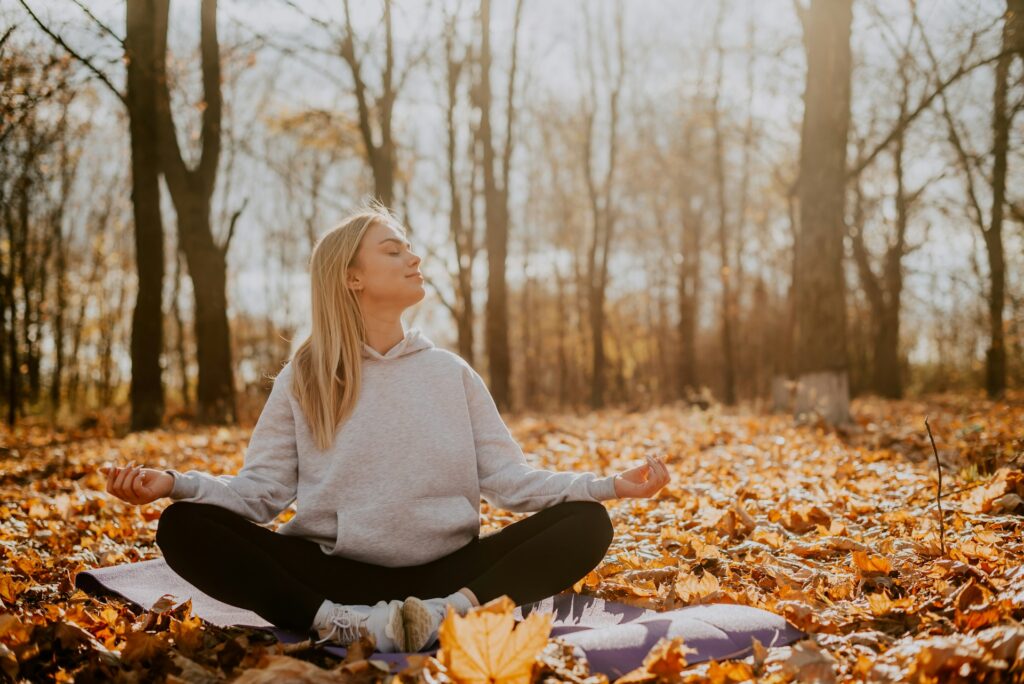Mindfulness doesn’t have to mean sitting cross-legged in silence for half an hour, you know.

If the idea of stillness stresses you out or just doesn’t suit your style, that’s completely fine. You can be mindful without ever setting foot on a meditation cushion. The whole point of mindfulness is to become more present—more aware of what’s happening in and around you. Luckily, there are plenty of ways to do that while moving, doing, or even fidgeting. Here are some simple ways to bring mindfulness into your life without having to sit still.
1. Go for a walk without your phone.

Leave your phone at home, or keep it on silent and out of sight. Instead of listening to music or checking messages, pay attention to what’s around you. Notice the sound of your footsteps, the feel of the air, the colours of your surroundings. That kind of mindful walking turns a regular stroll into a chance to actually be where you are. You don’t have to go far—just stay present with each step.
2. Cook a meal and focus only on that.

Instead of rushing through dinner prep with a podcast in the background, try cooking with your full attention. Focus on the textures, the smells, the way the ingredients change as you chop or stir. It’s less about doing everything perfectly and more about staying connected to what’s happening right in front of you. Cooking becomes less of a task and more of an experience.
3. Take a relaxing bath.

Baths are often when our brains go into overdrive, thinking about the day ahead or rehashing old conversations. Instead, try tuning in to the sensations—the warmth of the water, the scent of the soap, the rhythm of the droplets. Even a short shower can become a full-body mindfulness practice if you let yourself stay present with the experience.
4. Do one thing at a time (on purpose).

Multitasking is the enemy of mindfulness. Choose just one task—washing the dishes, folding laundry, brushing your teeth—and do only that. Not as a chore, but as an intentional act of attention. It’s not glamorous, but it’s grounding. Giving something your full focus reminds your brain how to stay in the moment without needing a formal practice.
5. Listen to music and really listen.

Not background noise, but actual listening. Put on a song you love and notice the layers: the instruments, the lyrics, the way the rhythm makes your body want to move. Let yourself get immersed in it without doing anything else. Music has a way of anchoring you in the now when you give it your full presence.
6. Stretch with intention.

You don’t need a whole yoga flow—just a few slow stretches done with full awareness. Tune into your body and move gently. Notice which parts feel tight, which ones release, how your breath changes. Performance and flexibility don’t matter here. It’s about reconnecting with your physical self in a way that feels nourishing and respectful.
7. Mindfully clean one small space.

Pick one drawer, one corner, one surface—and clean it slowly, without rushing. Feel the textures. Notice your movements. Let the task absorb your attention completely. Cleaning can feel strangely meditative when you do it with presence instead of just trying to get it done. The calm after is a bonus.
8. Eat one snack or meal without distractions.

No screens, no background shows—just you and the food. Eat slowly. Notice the flavours, the way the food feels, the point where you stop feeling hungry. Mindful eating doesn’t mean analysing every bite. It just means being present while you eat, instead of treating food like something to get through.
9. Drive in silence (or with quiet music)

Instead of blasting the radio or taking calls, try driving with the windows down, noticing the road, the wind, the feel of your hands on the wheel. Let it become a moving meditation. Mindful driving isn’t just calming—it can make you a safer, more aware driver too. It changes your autopilot into actual presence.
10. Tend to plants or nature.

Watering a houseplant, weeding a garden bed, even just watching birds out the window can be mindfulness in action. Nature has a way of slowing our internal pace. You don’t need a big garden or fancy setup. The key is to do it slowly, attentively, and with curiosity for what’s unfolding around you.
11. Engage your senses with texture.

Touch something with a strong or interesting texture—knitted fabric, smooth stones, soft moss. Let your hands explore without rushing or judging. Sensory grounding like this brings you back to your body. It’s a subtle way to anchor your attention and reduce mental noise.
12. Repeat a movement rhythmically.

Washing windows, sweeping, kneading dough—any repeated motion can become meditative if you focus on the movement itself. Let your body fall into rhythm, and your mind will often follow. You don’t have to try to be calm. The motion carries you there naturally, as long as you stay present with what you’re doing.
13. Use breath to anchor movement.

Even if you’re moving—walking, cleaning, getting dressed—you can tune in to your breath. Match your inhale and exhale to your pace or your gestures. Let it guide you rather than fighting for your attention. This simple breath-body connection helps you stay anchored. It turns regular routines into moments of mindfulness, without needing silence or stillness at all.


